The Mannerist Architectural and Park Landscape Complex and Pilgrimage Park in the Polish town of Kalwaria Zebrzydowska: The Calvary Sanctuary of Kalwaria Zebrzydowska is the second most important destination religious pilgrimage in Poland, the most important is the Monastery of Jasna Gora in Częstochowa. The Calvary of Kalwaria Zebrzydowska was founded by Mikołaj Zebrzydowski, a religious Polish nobleman, the calvary was built in 1605-1632 and served as an alternative for the dangerous and expensive pilgrimage to Jerusalem. The 17th century Basilica of Our Lady of Angels is the heart of the Sanctuary of Kalwaria Zebrzydowska. The 42 chapels of the calvary are scattered on the slopes of Żar Mountain in the foothills of the Carpathians. Each of the chapels is different, the most famous are the Chapel with the icon of Our Lady of Kalwaria and the Chapel of St. Anthony of Padua, both located in the Basilica of Our Lady of Angels. Now, Calvary of Kalwaria Zebrzydowska is still an important place of pilgrimage in Poland. The most famous pilgrim was the Polish-born Pope John Paul II. The calvary was built in the Mannerist style. Other Mannerist Architecture in Poland can be found in Zamość and Kraków. Kalwaria Zebrzydowska: The Mannerist Architectural and Park Landscape Complex and Pilgrimage Park gained the status as a UNESCO World Heritage in1999.
www.werelderfgoedfotos.nl © Copyright World Heritage Photos
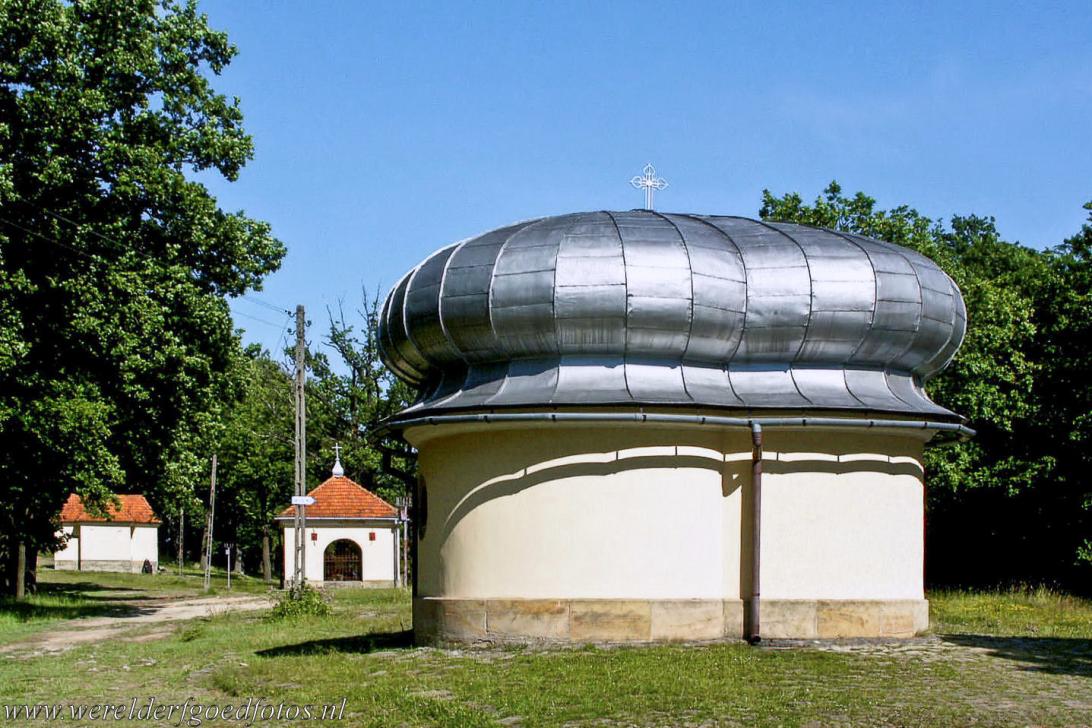
Calvary Sanctuary of Kalwaria Zebrzydowska: The Virgin Mary's Cottage. The Pilgrimage Park of Kalwaria Zebrzydowska is situated close to the Polish town of Kraków. The calvary is the largest calvary sanctuary in Europe, created to provide Christian pilgrims with a substitute of Jerusalem, the Holy City. The chapels of the calvary were built in the Baroque and Mannerist styles between 1605 and 1617. The Mannerist Architectural and Park Landscape Complex and Pilgrimage Park in Kalwaria Zebrzydowska was declared a UNESCO World Heritage in 1999.

Calvary Sanctuary of Kalwaria Zebrzydowska: The Virgin Mary's Cottage. The Pilgrimage Park of Kalwaria Zebrzydowska is situated close to the Polish town of Kraków. The calvary is the largest calvary sanctuary in Europe, created to provide Christian pilgrims with a substitute of Jerusalem, the Holy City. The chapels of the calvary were built in the Baroque and Mannerist styles between 1605 and 1617. The Mannerist Architectural and Park Landscape Complex and Pilgrimage Park in Kalwaria Zebrzydowska was declared a UNESCO World Heritage in 1999.
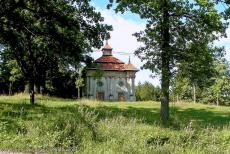
Calvary Sanctuary of Kalwaria Zebrzydowska: Herod's Palace is one of the stations. The Calvary of Kalwaria Zebrzydowska was founded by Mikołaj Zebrzydowski, a religious Polish nobleman. The Calvary of Kalwaria Zebrzydowska is widely known for its Stations of the Cross, the calvary is inspired by the Calvary of Jerusalem. De chapels are situated in the quiet landscape of southern Poland, each of the chapels is different. The chapels are connected by several Calvarian Paths, these overlapping paths are five km long.
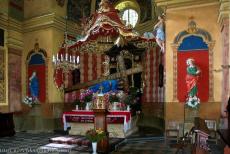
Calvary of Kalwaria Zebrzydowska: Each of the 42 chapels is different, they represent a location of Jerusalem in the New Testament and / or a Christian tradition. The chapel containing the icon of Our Lady of Kalwaria is the most worshiped chapel, followed by the chapel of St. Anthony of Padua, both are situated in the Basilica of Our Lady of Angels. Each year, thousands of pilgrims visit the icon of Our Lady of Kalwaria, one of the most sacred icons in Poland. The basilica is the starting point of several routes, the Calvarian Paths, connecting the chapels of the calvary.
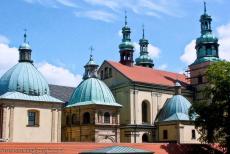
The Basilica of Our Lady of Angels is the heart of the Calvary of Kalwaria Zebrzydowska. The 17th century Baroque basilica adjoins a Franciscan monastery dating from the same period, the Basilica of Our Lady of Angels houses the miraculous icon of Our Lady of Kalwaria, according to the legend, the icon wept in 1641. The basilica is the starting point of several pilgrimage routes along the Stations of the Cross. The Calvary of Kalwaria Zebrzydowska is based on the Stations of the Cross in Jerusalem, the Via Dolorosa, the path Jesus walked on the way to his crucifixion.
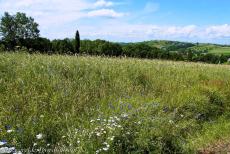
The Calvary of Kalwaria Zebrzydowska is based on the Via Dolorosa in Jerusalem. The chapels of the Calvary Sanctuary of Kalwaria Zebrzydowska are scattered on the slopes of the 527 metres high Żar Mountain in the foothills of the Carpathian Mountains, about 33 km southwest of the Polish town of Kraków. The hills and streams of the Pilgrimage Park of Kalwaria Zebrzydowska have names such as Zion, Mount of Olives, Gethsemane and Golgotha. Kalwaria Zebrzydowska is famous for its mystery plays and religious celebrations during the Holy Week.
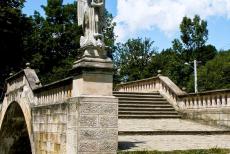
Calvary Sanctuary of Kalwaria Zebrzydowska: The Bridge of Angels is decorated with statues of archangels. The calvary was built in the small town of Kalwaria Zebrzydowska between 1605 and 1632, the park was created as an alternative for the dangerous and expensive pilgrimage to the Holy Land and Jerusalem. The park takes its name from the family name of the founder, Mikołaj Zebrzydowski. The Mannerist Architectural and Park Landscape Complex and Pilgrimage Park of Kalwaria Zebrzydowska was inscribed on the UNESCO World Heritage List in 1999.
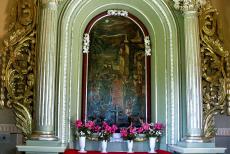
Calvary Sanctuary of Kalwaria Zebrzydowska: The altar inside one of the chapels. The calvary of Kalwaria Zebrzydowska is still an important place of Christian pilgrimage and Poland's second most important historic destination for pilgrims. The calvary is visited by more than one million people each year. The most famous pilgrim was the Polish-born Pope John Paul II, he visited the Pilgrimage Park of Kalwaria Zebrzydowska in 1979 and 2002. Karol Wojtyla, the later Pope John Paul II, was born in Wadowice, a small town situated about 15 km from Kalwaria Zebrzydowska.
